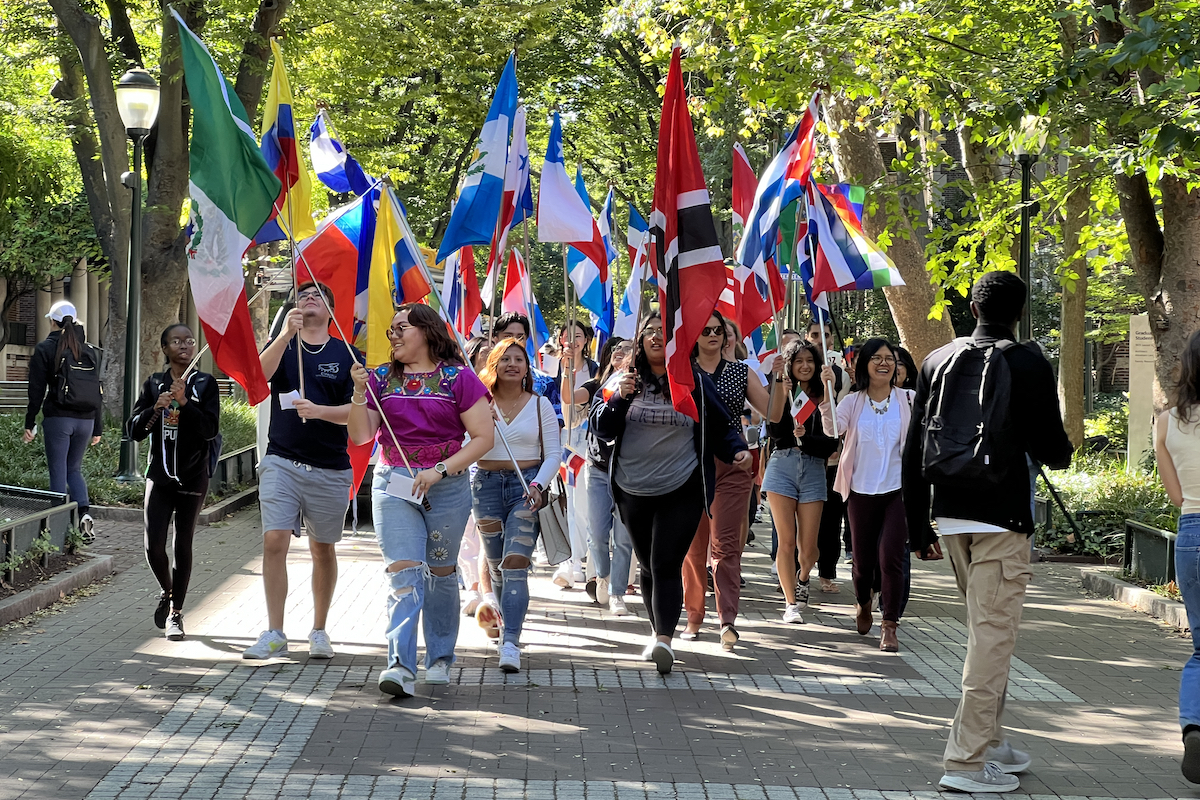
The March of Flags on Sept. 15, organized by La Casa Latina. Students walk down Locust Walk carrying flags from the country where they or their families came from. (Image: Sarah Flores, University Life)
Latinx Heritage Month, celebrated each year in the U.S. from September 15 to October 15, recognizes the “histories, cultures, and contributions of American citizens whose ancestors came from Spain, Mexico, the Caribbean, and Central and South America.” This broad umbrella encompasses the scholarship of many faculty and graduate students in Penn Arts & Sciences, across departments and centers from Sociology and Africana Studies to the Center for Latin American and Latinx Studies (CLALS) and beyond.
“We’re celebrating Latin America and the Latinx diaspora the whole year,” says Catherine Bartch, CLALS associate director. “But I think it’s so important that we have a month dedicated to really celebrate and honor the rich and diverse contributions of these groups of people.”
Here, Bartch and others reflect on what it means to the Penn community and beyond to have this time set aside.
Emilio Parrado, Dorothy Swaine Thomas Professor of Sociology and director of the Population Studies Center, co-founded CLALS with Tulia Falleti, Class of 1965 Endowed Term Professor of Political Science. Parrado has also spent many years working closely with the Latinx immigrant population in Philadelphia.
Latinx Heritage Month is important, of course, because it celebrates the cultural and historical contributions that Hispanics have made to the U.S. For me the month is special, too, because in addition to having that historical function, it is a mobilizing force to organize events, visits, celebrations, talks, and so forth that help connect the Hispanic community in its many expressions in the U.S. but also in Latin America. It serves as a catalyst for building connections, learning about opportunities, honoring members of the Hispanic and Latin American communities, and it gives us the chance to pause, reflect, celebrate, and learn about our community and its present contributions.
Yasmin Mertehikian is a Ph.D. candidate in sociology and demography. Her dissertation work focuses on analyzing the impact of the COVID-19 pandemic on labor market outcomes in Argentina. She is from Buenos Aires, Argentina.
Before coming to the U.S., I hadn’t considered myself Latinx. I had always based my identity on my nationality. But as soon as I got here, I started feeling like I was missing that sense of community. The Center for Latin American and Latinx Studies gave me that. Speaking all day in another language that’s not your first language can be a challenge, but also the need to meet people who are in a similar situation—away from their families, getting used to a different culture, especially during the pandemic—it gave me a sense of community that I hadn’t felt like I needed before. That’s when I started identifying myself, rather than just being Argentine, as being part of a larger region, as being Latinx. I’m glad that there’s a month specifically designed to reflect on Latinx identities, but I wish we didn’t need a month for it, that it was just as widely accepted as any other form of identity.
Catherine Bartch is associate director of CLALS, which was established in 2021, building on the three-decade-old Latin American and Latino Studies Program.
Since I started in 2016, you can see the growth of our faculty and staff who study Latin America and Latinx issues but who also identify in this way. We now have more than 70 affiliated faculty and we’re still growing. I think it’s a reflection of the increase in people who identify as Hispanic or Latinx in the United States. The latest figures I saw were that 19 percent of the U.S. population identified in this way.
At CLALS, we celebrate Latinx Heritage Month all year ’round, but we also try to coordinate our programming around Latinx Heritage Month. We had an event that included artist Roberto Mamani Mamani and several other events that remembered the horrible coup that overthrew a democratically elected government in Chile on Sept. 11, 1973. The community came together for La Casa Latina’s March of Flags, the big celebration of students walking down Locust Walk carrying flags from the country where they or their families came from. We’ve had faculty like Kristina Lyons, associate professor of anthropology, and Jon Hawkings, assistant professor of earth and environmental science, hosting a series of talks looking at environmental justice issues in Latin America. And there’s so much more because as I said, for us, we’re constantly celebrating Latinx heritage. It’s great the United States has this month and that we recognize it here at Penn.
Natalia Reyes is a Ph.D. candidate in English focusing on ethnic American literatures. She is also a member of the CLALS Graduate Advisory Board and co-coordinator of the English department’s Latinx Working Group. This semester she is teaching a course called Love and Rockets: The Great American Comic Book.
“Hispanic Heritage Month” is not, to me, a misnomer or proof that “Hispanic” people in the U.S. generally align with that identity category. Quite the opposite: The name alone is proof that much work remains to be done so that Latinx contributions to U.S. culture and society are properly celebrated and championed.